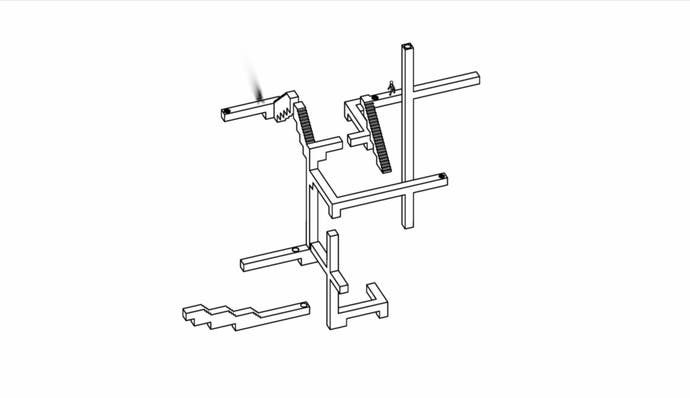GDC: echochrome
We tumble and grin through three levels.
With echochrome due out in Japan this time next month for PSP and PS3's PlayStation Network, Sony brought along a tutorial and three-level demo for Game Developers Conference attendees to wrap their confused eyes and hands around. We played it. Now we're writing about it. Having a good time? Can I get you anything?
Like the Tokyo Game Show demo we told you about in September, this one begins with a tutorial that outlines the concept. No need to waste too much time repeating ourselves; you rotate the camera around a series of disconnected walkways peppered with holes and jump-pads, as a little man walks around, and the angle the camera has on proceedings determines whether things like gaps and holes and jump-pads are active. If there's an illusion of solidity, or of one thing being above another, then for the purposes of the puzzle, it is so.
The three actual game levels are quick to test your understanding. As you drag the camera around with the right analogue stick, using R1 to speed up its movement, X to increase the little man's walking speed, and triangle so he can pause to "think", you realise there's more than one solution. The object is to help him make his way to several ghostly black outlines, but you can do them in whichever order comes to mind. Moving the camera so that a high beam appears beneath a hole in the starting walkway allows you to drop down (or, rather, up), but you can also align a pair of beams at different levels so that the edges come together, at which point the black outlines dividing them disappear, creating a single platform to walk along.

Calling these things to mind isn't as simple as seeing them once and then doing it. We and a few others in the Sony lounge (good biscuits) stared for ages at the third level, which consists of a high beam with stairs dipping down in the middle, and an E shape lying on its side at the same height with a similar further down, and couldn't work out how to get off it. In the end it was simple: align one of the Es, as above, with the high starting beam, and the little man wanders off into E-land.
Then you quickly have to rotate the camera to avoid falling through a hole or using a jump-pad. Simply dropping the camera below a beam with a hole isn't enough, because you can still see the exit hole, and that's enough for the little man to tumble through. It has to be completely obscured. The next move was to jump our little friend onto a beam directly below the starting platform, book-ended by vertical beams that attached it to the one above it. Jumping did the trick. But then how to escape from walking back and forward along the small walkway forever? Another bit of E-edge alignment.
Before long, we were all done, and left to ponder. For all its high concept and delightful logic, echochrome is actually a bit simple. There aren't many rules to grasp, and there's some inconsistency too; the camera physically refuses to align with platforms in certain ways, snapping above or below them when you try to create a flat plane, and the ability to pause for "thinking" is a bit of a cheat, because it allows you to land on the lip of a hole, which you would otherwise fall through, pause movement, and then rotate the camera until it's properly obscured, at which point you can resume.

The difficulty curve, and avoiding too many conveniences like the thinking button, will probably be key to whether echochrome actually works long haul. Unless Japan Studio 'does a Portal' on us, it will have to be extremely smart about how it puts these concepts to use over the course of several hours, or risk accusations of spiking difficulty (the demo levels are a bit out of touch with one another) or not providing enough distinctive content.
Still, it's a bit early to be moaning, so we won't. echochrome is still a fascinating exercise in intuitively breaking the laws of physics and logic to challenge and entertain, and it's lovely simply to watch, and sit around pointing at and making suggestions. Delivered in lovely 1080p on a big screen with dinner music stringing along in the background, you can happily imagine picking away at it quietly or leaving it on when your friends come round. Look out for a European release in Q2, and look out for our review of the Japanese version just as soon as it comes out next month.







.png?width=291&height=164&fit=crop&quality=80&format=jpg&auto=webp)


